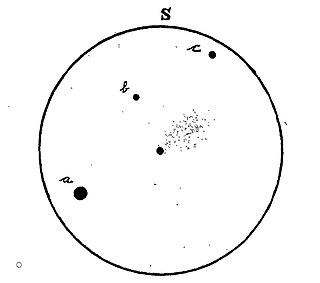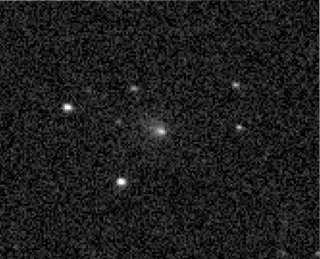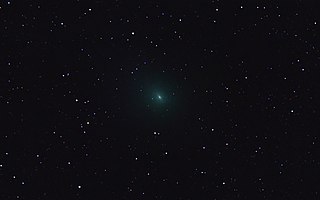Related Research Articles

28P/Neujmin, also known as Neujmin 1, is a large periodic comet in the Solar System. With a perihelion distance of 1.5AU, this comet does not make close approaches to the Earth.
42P/Neujmin, also known as Neujmin 3, is a periodic comet 2 km in diameter.

52P/Harrington–Abell is a periodic comet in the Solar System.

60P/Tsuchinshan, also known as Tsuchinshan 2, is a periodic comet in the Solar System with an orbital period of 6.79 years. Tsuchinshan is the Wade-Giles transliteration corresponding to the pinyin Zĭjīn Shān, which is Mandarin Chinese for "Purple Mountain".

105P/Singer Brewster is a periodic comet in the Solar System. It was discovered in 1986, and received the name of 1986d under the old naming system.
169/NEAT is a periodic comet in the Solar System. It is the parent body of the alpha Capricornids meteor shower in Late July. 169/NEAT may be related to comet P/2003 T12 (SOHO). It comes to perihelion on 9 July 2022. On 13 July 2022 passed 0.1395 AU (20.87 million km) from Venus. On 11 August 2026 it will pass 0.1672 AU (25.01 million km) from Earth and then come to perihelion on 21 September 2026.

6P/d'Arrest is a periodic Jupiter-family comet in the Solar System, orbiting between Mars and Jupiter. It passed 0.15124 AU from the Earth on August 12, 1976. The most recent perihelion passage took place on September 17, 2021, when the comet had a solar elongation of 95 degrees at approximately apparent magnitude of 10.

Comet Finlay is a periodic comet with an orbital period of 6 years discovered by William Henry Finlay on September 26, 1886. The next perihelion passage is July 13, 2021 when the comet will have a solar elongation of 54 degrees at approximately apparent magnitude 10. It last came to perihelion on December 27, 2014, at around magnitude 10. Of the numbered periodic comets, the orbit of 15P/Finlay has one of the smallest minimum orbit intersection distances with the orbit of Earth (E-MOID). In October 2060 the comet will pass about 5 million km from Earth.

166P/NEAT is a periodic comet and centaur in the outer Solar System. It was discovered by the Near Earth Asteroid Tracking (NEAT) project in 2001 and initially classified a comet with provisional designation P/2001 T4 (NEAT), as it was apparent from the discovery observations that the body exhibited a cometary coma. It is one of few known bodies with centaur-like orbits that display a coma, along with 60558 Echeclus, 2060 Chiron, 165P/LINEAR and 167P/CINEOS. It is also one of the reddest centaurs.

Comet C/2006 M4 (SWAN) is a non-periodic comet discovered in late June 2006 by Robert D. Matson of Irvine, California and Michael Mattiazzo of Adelaide, South Australia in publicly available images of the Solar and Heliospheric Observatory (SOHO). These images were captured by the Solar Wind ANisotropies (SWAN) Lyman-alpha all-sky camera on board the SOHO. The comet was officially announced after a ground-based confirmation by Robert McNaught on July 12.
Comet Crommelin, also known as Comet Pons-Coggia-Winnecke-Forbes, is a periodic comet with an orbital period of almost 28 years. It fits the classical definition of a Halley-type comet with. It is named after the British astronomer Andrew C. D. Crommelin who calculated its orbit in 1930. It is one of only four comets not named after their discoverer(s), the other three being Comets Halley, Encke, and Lexell. It next comes to perihelion around May 27, 2039 when it will be near a maximum near-perihelion distance from Earth.

45P/Honda–Mrkos–Pajdušáková is a short-period comet discovered by Minoru Honda December 3, 1948. It is named after Minoru Honda, Antonín Mrkos, and Ľudmila Pajdušáková. The object revolves around the Sun on an elliptical orbit with a period of 5.25 years. The nucleus is 1.3 kilometers in diameter. On August 19 and 20, 2011, it became the fifteenth comet detected by ground radar telescope.

144P/Kushida is a periodic comet discovered in January, 1994, by Yoshio Kushida at the Yatsugatake South Base Observatory in Japan. This was the first comet discovery of 1994 and his second discovery within a month. It next comes to perihelion on 25 January 2024 and should brighten to about magnitude 9.

94P/Russell 4 is a periodic comet in the Solar System. It fits the definition of an Encke-type comet with. It was discovered by Ken Rusell on photographic plates taken by M. Hawkins on March 7, 1984. In the discovery images, Russell estimated that the comet had an apparent magnitude of 13 and a noticeable tail of 5 arc minutes. In the year of discovery, the comet had come to perihelion in January 1984.

43P/Wolf–Harrington is a periodic comet discovered on December 22, 1924, by Max Wolf in Heidelberg, Germany. In 2019 it passed within 0.065 AU of Jupiter, which lifted the perihelion point and increased the orbital period to 9 years.
255P/Levy, formerly P/2006 T1 and P/2011 Y1, is a periodic comet with an orbital period of 5.25 years. It last came to perihelion on 14 January 2012. During the 2006 passage the comet achieved an apparent magnitude of ~9.5. Levy (PK06T010) was believed to have been recovered on 3 June 2011 at magnitude 19.8, but other observatories were unable to confirm a recovery. It was most likely a false positive because of large residuals. Levy was recovered on 17 December 2011 at magnitude 19.8, and given the second designation 2011 Y1. It was then numbered.

62P/Tsuchinshan, also known as Tsuchinshan 1, is a periodic comet discovered on 1965 January 1 at Purple Mountain Observatory, Nanking. It will next come to perihelion on 25 December 2023 at around apparent magnitude 8, and will be 0.53 AU (79 million km) from Earth and 110 degrees from the Sun.

246P/NEAT is a periodic comet discovered on 2004 March 28 by Near-Earth Asteroid Tracking (NEAT) using the 1.2-metre (47 in) reflector at Haleakala. It was given the permanent number 246P on 2011 January 14.
C/2013 V5 (Oukaimeden) is a retrograde Oort cloud comet discovered on 12 November 2013 by Oukaimeden Observatory at an apparent magnitude of 19.4 using a 0.5-meter (20 in) reflecting telescope.

C/2013 US10 (Catalina) is an Oort cloud comet discovered on 31 October 2013 by the Catalina Sky Survey at an apparent magnitude of 19 using a 0.68-meter (27 in) Schmidt–Cassegrain telescope. From September 2015 to February 2016 the comet was around apparent magnitude 6. The comet took around a million years to complete half an orbit from its furthest distance in the Oort cloud and should be ejected from the Solar System over many millions of years.
References
- 1 2 "IAUC 8429: C/2004 V3; C/2004 V4; 78P". IAU Central Bureau for Astronomical Telegrams. 2004-11-06. Retrieved 2012-02-28.
- ↑ "JPL Small-Body Database Browser: 163P/NEAT" (last observation: 2012-01-20). Jet Propulsion Laboratory . Retrieved 2012-02-28.
- 1 2 Syuichi Nakano (2011-10-12). "163P/NEAT (NK 2129)". OAA Computing and Minor Planet Sections. Retrieved 2012-02-28.
- 1 2 "163P/NEAT Orbit". Minor Planet Center . Retrieved 2014-06-18.
- ↑ Seiichi Yoshida (2011-10-01). "163P/NEAT". Seiichi Yoshida's Comet Catalog. Retrieved 2012-02-28.
- ↑ Maik Meyer (2004). "The precovery of comet 163P/2004 V4 (NEAT)". Catalogue of Comet Discoveries. Retrieved 2012-02-28.
- ↑ "MPEC 2004-X29 : COMET P/2004 V4 (NEAT)". IAU Minor Planet Center. 2004-12-08. Retrieved 2012-02-28.
- ↑ Seiichi Yoshida (2005-04-23). "163P/NEAT (2005)". Seiichi Yoshida's Comet Catalog. Retrieved 2012-02-28.
- ↑ "JPL Close-Approach Data: 163P/NEAT" (last observation: 2012-01-20). Retrieved 2012-02-28.




